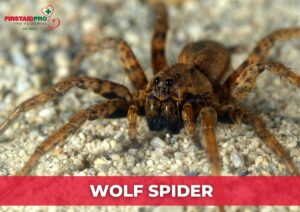Huntsman spiders, well-known in Australia, are a source of fear for those with a phobia of spiders, largely because of their considerable size, rapid movement, and preference for residing in homes. While they primarily feed on insects and small invertebrates, many individuals have experienced being bitten by these spiders.
In Australia, huntsmen spiders are iconic due to their impressive size, unique appearance, and prevalence. Their name has been adopted by various businesses and entities, including automotive part manufacturers and fictional literary groups. For tourists, the experience of encountering these palm-sized spiders on the ceiling above their beds can be particularly daunting.
Equip yourself with the confidence and skills to handle such situations by enrolling in a First Aid course with First Aid Pro in Adelaide. Our comprehensive training will provide you with the knowledge and hands-on experience to effectively manage spider bites and a wide range of other emergencies.
Take charge of your safety and the well-being of those around you. Enroll in a First Aid Pro course today, and turn your fear into readiness. Visit us at First Aid Pro Adelaide to secure your spot and be prepared for whatever comes your way!
What Are “Huntsmans”?
Huntsman spiders, a collection of species within the Sparassidae family, are often referred to as wood spiders, due to their preference for tree bark and woodpile habitats, and giant crab spiders, attributed to their size and crab-like leg structure.
These spiders frequently cause alarm for various reasons but in reality they are low on the scale of venomous spiders. Typically as big as a human palm they are known for their active hunting behavior, not using webs but instead chasing their prey at speeds surpassing human walking pace, and they are infamous for their ability to jump. Their distinctive, spider-like movement often unnerves people.
Their ability to blend in is enhanced by their grey or brown bodies, which camouflage well against bark and wood, and they can be equally inconspicuous on carpets. Huntsman spiders are adept at squeezing into small spaces, leading to surprising encounters with large spiders emerging from seemingly inadequate gaps. Inside homes, they are notorious for occupying high areas on walls or ceilings, remaining conspicuously in view.
Consequently, it’s not rare for Australians to encounter these sizable, agile spiders in their homes, whether it’s a fist-sized spider on the ceiling at night or a sudden appearance of one nearby.
What Does A Huntsmen Spider Look Like?
As mentioned, these spiders typically exhibit brown or grey hues and are notably hairy. Their bodies measure approximately 15mm-20mm in length, including the abdomen which itself is roughly akin to the size of a human fingerprint.
Their characteristic long, slender legs possess a unique twist, with knees bending backwards, allowing them to stretch forward for capturing prey, resembling a crab’s posture. When their legs are fully extended, they can span the size of a human palm, about 5cm-8cm, though some huntsmen can reach up to 15cm in width.
Wolf Spider VS Huntsman


The huntsman spider is frequently mistaken for the wolf spider, as they share several characteristics. Both are quick-moving, do not construct webs, and resemble each other in size, shape, and color.
Typically, the body of the huntsman spider (excluding the abdomen) appears broader than its length and has a relatively unadorned coloration.
In contrast, the wolf spider boasts a more elongated body adorned with distinctive markings, such as a “cat’s eye” pattern or stripes emanating from its back’s center, sometimes featuring both. Additionally, its legs are jointed in a vertical manner, giving it a less crab-like appearance compared to the huntsman. Essentially, the wolf spider could be described as a huntsman endowed with a better fashion designer.
Can A Huntsman Spider Bite?
Huntsmen spiders are capable of biting if they feel provoked. While they typically avoid confrontations with humans, preferring to conceal themselves, they may become aggressive if they sense a threat or need to defend their offspring.
When a huntsman spider senses danger or finds itself trapped, it often exhibits a warning behavior by rearing up and brandishing its front legs. This gesture is a clear signal in the spider world, equivalent to a challenge or a readiness to engage in combat.
If you encounter a huntsman displaying this behavior, it’s advisable to retreat and give the spider some room, as it may be preparing to advance and potentially bite. It’s important to remember that huntsmen can move unexpectedly fast and are also capable of jumping.
Prevent Spider bites
When a huntsman spider feels threatened while attached to a wall or ceiling, it may abruptly pull its legs close to its body. This action is a cue to maintain distance, as it often precedes the spider’s just letting itself drop.
Huntsmen spiders are notably defensive of their offspring, showing increased aggression when safeguarding an egg-sack or their newly hatched young. If you encounter a huntsman spider with a significantly swollen abdomen, possibly indicating pregnancy and the presence of an egg sack, it’s wise to stay away. Such a situation however, might also prompt a decision to remove the spider, especially considering that female huntsmen can lay up to 200 eggs in a single egg sack.
How Dangerous Is A Huntsman Spider Bite?
Despite the intimidating nature of huntsman spiders when approached closely, they are low in dangerous spider venom are not considered hazardous and rank among the less venomous spider varieties in Australia. While a bite from a huntsman spider can be painful due to their large size and formidable jaws, the typical consequences are usually limited to short-term pain, along with potential swelling, itchiness, and inflammation. By Australian standards this is harmless when compared to a redback spider bite or that of a funnel web spider.
In some cases, the victim might also suffer from nausea or headaches. The most significant symptoms are often caused by the bite itself, rather than the venom and the victim should experience only mild reactions.
A 2003 study, which analysed 168 instances of huntsman spider bites, revealed that although the bite itself tends to be more painful than that of an average spider, the impact of their venom on humans is typically much less severe. The venom of a huntsman spider is not highly effective against humans.
On rare occasions, bites from huntsman spiders, or even mere contact with their skin, can trigger allergic reactions. However, such instances are infrequent – the study from 2003 did not record any cases of anaphylaxis among the 168 individuals bitten. Nonetheless, it remains important to monitor anyone who has been bitten or stung for symptoms of an anaphylactic reaction.
Huntsman Spider Bite Mark
What are the characteristics of a huntsman spider bite? Typically, the area of the bite will display two puncture marks spaced a few millimeters apart. Sometimes, only a single puncture mark is visible, possibly due to the proximity of the wounds making them indistinguishable or because just one fang made contact with the skin. The surrounding area of the bite may show some inflammation and minor bleeding.
In most instances, identifying the cause of the bite is straightforward. If bitten by a huntsman spider, it’s usually quite evident.
Huntsman Bite First Aid
Administering first aid for a huntsman spider bite is fairly straightforward, yet it’s beneficial to undergo a first aid course to be prepared for such scenarios. After ensuring the spider is no longer a threat to others, cleanse the bite area thoroughly, followed by the application of an ice pack or cold pack to reduce swelling and alleviate pain.
It’s important to maintain the calmness of the person bitten, offering reassurance that the venom of huntsman spiders has a negligible effect on humans. Avoid placing pressure on the wound, or applying a bandage, as this will only make it hurt more. Conventional painkillers such as paracetamol can also help lessen the discomfort.
Should the individual bitten exhibit signs of an allergic reaction, vigilant monitoring is crucial. Pay special attention if symptoms of anaphylaxis appear, like throat tightness or swelling, breathing difficulties, or tongue swelling, and seek immediate medical assistance. In cases of severe symptoms, call triple zero (000) promptly.
For those at known risk of anaphylaxis, carrying an adrenaline injector, such as an EpiPen or AnaPen, is common, and it may be necessary to use it if the reaction becomes critical.
In the event of a spider bite, if there’s a first aid officer or someone trained in first aid nearby, inform them. They are skilled in identifying anaphylaxis signs and knowledgeable about the appropriate use of an EpiPen.
Additionally, for those residing in spider-prone areas or with family members who have a history of anaphylaxis, it’s advisable to consider undergoing professional first aid training to be well-prepared for any emergency.
Summing Up
In conclusion, the menacing appearance of the huntsman spider, with its large size and rapid movements, often incites fear, especially in Australian homes where they are commonly encountered. Despite their intimidating presence, huntsman spider bites are generally not a significant threat to humans.
While the bite can be painful due to the spider’s size, the venom of the huntsman is relatively harmless to humans, typically resulting in temporary pain, swelling, and minor skin irritation. Serious allergic reactions are rare.
If bitten, basic first aid, such as cleaning the wound and applying ice to reduce swelling, is usually sufficient. It’s always prudent to monitor the bite for any signs of an allergic reaction and seek medical attention if symptoms worsen. Ultimately, while their appearance may be alarming, huntsman spiders are far less dangerous than their formidable reputation suggests.
Frequently Asked Questions
Huntsman spider bites do inject venom, but it is relatively harmless to humans. The effects are usually limited to temporary pain, swelling, and minor skin irritation. Serious complications are rare, making these bites less dangerous than commonly feared.
If bitten, wash the bite area with soap and water, apply a cold pack to reduce swelling and relieve pain. Over-the-counter painkillers like paracetamol can help. It’s important to keep an eye on the bite for signs of an allergic reaction and seek medical attention if symptoms worsen.
While uncommon, huntsman spider bites can sometimes trigger allergic reactions in sensitive individuals. Symptoms to watch for include swelling, difficulty breathing, or anaphylaxis. Immediate medical attention is necessary if these symptoms appear.
Usually, a bite from a huntsman spider appears as two puncture marks separated by a few millimeters, although occasionally only a single puncture wound may be noticeable. There may be slight inflammation and minor bleeding around the bite site.
Huntsman spiders are large, typically brown or grey, and hairy. Their body shape is crab-like, with long, thin legs that extend forward. They can be as large as a human palm. In contrast, wolf spiders, often mistaken for huntsman spiders, have a more elongated body and distinctive patterns on their back.
Huntsman spiders are generally not aggressive towards humans and prefer to avoid contact. Bites usually occur only if the spider is provoked or feels threatened, such as when accidentally trapped against the skin or when protecting their young.
Huntsman spiders are found in various parts of the world, including Australia. They prefer natural environments like woodpiles and tree bark but are also known to venture into human dwellings. They often hide in small spaces and can be seen on walls or ceilings indoors.








